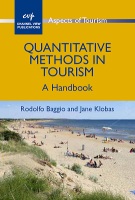|
| Turismo | IT & Internet | Pagine Sparse | Astronomia | Curriculum |
Tourism studies often deal with complex mixes of external and local factors and the attitudes, perceptions and actions of tourists themselves. In seeking to understand individual elements of this mix, or the results of interactions between them, tourism authorities, managers and researchers often collect quantitative data, but until now the few existing guides to understanding quantitative data have been either very simple or very complicated. This book provides a guide to dealing with real-world data and goes beyond the methods usually covered in introductory textbooks. The first part considers key issues associated with using well-known methods to produce valid and reliable models of real-world phenomena, emphasizing issues in data selection, approaches to factor and cluster analysis, and mathematical modelling using regression methods (including logistic regression) and structural equation modelling. The second part covers new approaches to modelling: maximum likelihood estimation, simulation and agent-based modelling. Each chapter includes extensive references to additional reading, and an appendix summarises the software introduced in the book. Part 1: The Analysis of Data "The authors have produced an informative, interesting and timely book on quantitative methods for tourism. The book is well-written and provides examples throughout thus making the challenging content very accessible. Software programs are also highlighted to assist researchers in choosing the right tools for the job. This book is a must-read for both researchers and research students, especially those who want an understanding of emerging techniques to advance the tourism field." Brent W. Ritchie, The University of Queensland, Australia "This is a book that is urgently needed and fills a gap in tourism. Quantitative Methods in Tourism is well crafted and unique in its coverage and scope. The book takes you from data generation to hypothesis testing, data analysis, model building to multivariate statistics, forecasting and simulation. It is an excellent addition to the scholarly tourism literature. It is a must have book for anyone who is involved in tourism analysis and research." Muzaffer Uysal, Virginia Polytechnic Institute & State University, USA "This book presents an interesting and exciting perspective regarding research methods in tourism. I would encourage tourism scholars and practitioners to pick up a copy as it will help them better understand and appreciate how to address the many challenges facing tourism research." Daniel R. Fesenmaier, Temple University, USA Read an excerpt (pdf file) More info: Publisher's website
|
 QUANTITATIVE METHODS IN TOURISM
QUANTITATIVE METHODS IN TOURISM